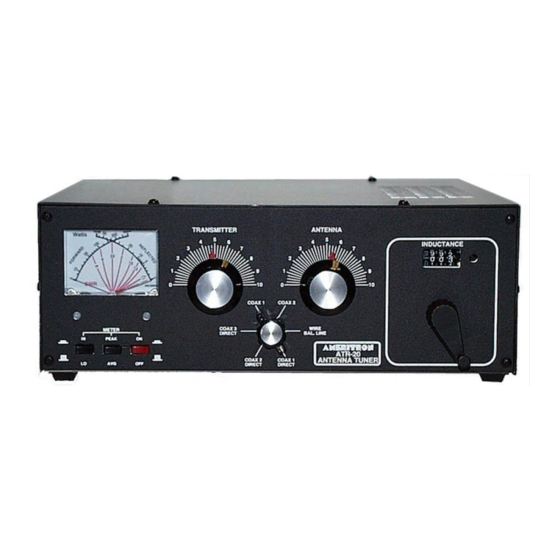- ページ 7
チューナー AMERITRON ATR-20のPDF 取扱説明書をオンラインで閲覧またはダウンロードできます。AMERITRON ATR-20 10 ページ。 Antenna tuner

ATR-20 Instruction Manual
coaxial cables, even when feeding groundplane or gamma matched antennas, since systems are
seldom perfectly designed or constructed.
3. Avoid feeding unbalanced antennas (like verticals) with balanced feedlines. Even if a good balun is
used at the tuner, the line will still radiate.
4. Good antenna and feedline balance will often reduce RFI to your neighbors, as well as reduce noise
coupled into your receiver from the feedline.
6.1
Location
For the best performance, an end-fed longwire wire antenna should be at least one quarter-wavelength
long at the operating frequency. Horizontal dipole antennas should be at least a half-wavelength long
and located as high and clear as possible. While good RF grounds help the signal in almost any
transmitting installation, it is extremely important to have good RF grounds with long wire or other
Marconi style antennas.
6.2
Matching Problems
Most matching problems occur when the antenna system presents an extremely high impedance to the
tuner. When the antenna impedance is much lower than the feedline impedance, an odd quarter-
wavelength feedline converts the low antenna impedance to a very high impedance at the tuner. A
similar problem occurs if the antenna has an extremely high impedance and the transmission line is a
multiple of a half-wavelength. The half-wavelength line repeats the very high antenna impedance at the
tuner. Incorrect feedline and antenna lengths can make an otherwise perfect antenna system very
difficult or impossible to tune.
One example where this problem occurs is on 80 meters when an odd quarter-wave (60 to 70 foot) open
wire line is used to feed a half-wave (100 to 140 foot) dipole. The odd quarter-wave line transforms the
dipole's low impedance to over three thousand ohms at the tuner. This is because the mismatched
feedline is an odd multiple of 1/4 wavelength long. The line inverts (or teeter-totters) the antenna
impedance.
A problem also occurs on 40 meters with this same antenna example. The feedline is now a multiple of
a half-wave (60 to 70 foot) and connects to a full-wave high impedance antenna (100 to 140 foot). The
half-wave line repeats the high antenna impedance at the tuner. The antenna system looks like several
thousand ohms at the tuner on 40 meters.
This places enormous strain on the balun and the insulation in the tuner, since voltages can reach several
thousand volts. This can cause component arcing, heating, and failure.
The following suggestions will reduce the difficulty in matching an antenna with a tuner:
1. Never center feed a half-wave multi-band antenna with a high impedance feedline that is close to an
odd multiple of a quarter-wave long.
2. Never center feed a full-wave antenna with any feedline close to a multiple of a half-wave long.
3. If this tuner will not "tune" a multi-band antenna, add or subtract 1/8 wave of feedline (for the band
that won't tune) and try again.
4. Never try to load a G5RV or center fed dipole on bands far below the half-wave design frequency. If
you want to operate an 80 meter antenna on 160 meters, feed either or both conductors as a longwire
against the station ground.
7
Ameritron Antenna Tuner
